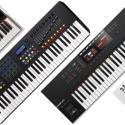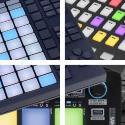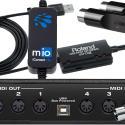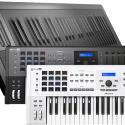What Is MIDI? An Overview
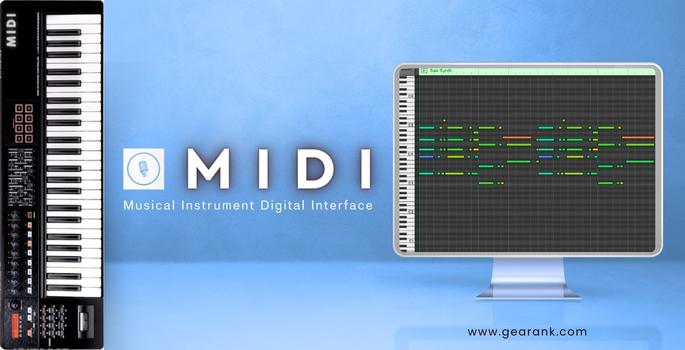
If you're new to recording music, then you will eventually come across the question, "What is MIDI?". This article will give you an overview of this topic, including the functions of MIDI, and MIDI devices.
MIDI, which was introduced in the 1980s, has had a significant impact on music production. Today, a vast majority of successful songs are produced using MIDI. However, to create the best-sounding tracks, it is essential to have a good understanding of MIDI. Unfortunately, many beginners struggle to use it to its full potential.
To enable experimentation, it is paramount to have a deep understanding of how MIDI works. Whether you are using hardware synths or a DAW, this article will provide comprehensive information on how MIDI operates, which settings to adjust for specific sounds, and what controllers you can use to your advantage.
What is MIDI - Musical Instrument Digital Interface
MIDI, which stands for Musical Instrument Digital Interface, is a well-established protocol that enables digital instruments to communicate with other digital instruments or DAWs (Digital Audio Workstation).
The MIDI protocol offers composers and music producers unparalleled control over the notes of a digital musical instrument. MIDI utilizes hardware and sound banks that provide various instruments, from synthesizers to real instrument sounds.
MIDI functions similarly to sheet music but with much greater sophistication. Rather than relying on individual instrumentalists to play the notes, MIDI allows you to choose the instruments to play the MIDI note(s) from a sound bank. This is done inside a MIDI sequencer, a DAW, or a MIDI keyboard.
MIDI essentially acts as a language between the controller and the computer, allowing you to create music on various computers, provided they are MIDI-compatible. By playing notes on a MIDI controller, you can make versatile and expressive music.
MIDI Data and MIDI Controllers
MIDI is a protocol that enables different MIDI-compatible devices to communicate. While it is often used in music production, it does not record sound. Instead, MIDI records data that describes how a musical performance was played. This data includes information about which notes were played, how they were played, and how long they were sustained.
MIDI data is transmitted in the form of messages that are sent in real-time from a MIDI keyboard or sequencer to external hardware or a DAW with an instrument plugin. This data is then interpreted by a sound module or plugin, which generates sound based on the instructions received.
This means that virtual instruments within a DAW can communicate with one another as long as they are both MIDI-compatible. By leveraging the power of MIDI, music producers and composers can create complex arrangements and orchestral compositions that would be difficult to achieve with traditional recording techniques alone.
MIDI Messages
MIDI messages are a versatile tool that can control various aspects of your DAW or external hardware. There are two types of MIDI messages, namely system and channel messages.
System messages are unrelated to the MIDI performance data and are primarily used for clock syncing between multiple devices. They ensure that all synced devices start and stop together and are in sync.
On the other hand, channel messages carry the actual music performance data of the MIDI controller. These messages contain critical data such as the pressed key's note number, velocity, and duration. The most common MIDI channel messages include note On/Off, Control Change, Program Change, and Pitch Bend messages. Here are some of the most common MIDI channel messages:
-
Note On/ Note Off: When a MIDI keyboard is played, it sends a signal to the sound module or plugin, which receives a note on message. When the keys are released, a note off message is sent.
-
Velocity: This parameter determines the volume of the note played and is controlled by the pressure of the keys on the MIDI keyboard or the assigned value in the sequencer, with a range of 0-127.
-
Aftertouch: This MIDI data specifies the pressure applied after pressing keys. It is utilized to add expressiveness to the sound.
-
Pitch bend: Indicates how far you want to bend the note from its original pitch. Pitch bend wheels are heavily used for guitar instrument patches.
After creating a basic music performance using channel messages, you can use them to modify and control the performance. MIDI provides you with ample opportunities to experiment.
A MIDI message sent at a specific time, such as in a sequencer, is called a MIDI event.
MIDI channels
MIDI channels work similarly to multiple tracks in a Digital Audio Workstation (DAW). You can assign each channel with its own unique MIDI instrument.
Each MIDI device has 16 assignable channels that enable you to control each separately with their sounds. You can also manipulate all of them at once by setting it to OMNI mode, which allows you to send the MIDI message to all 16 channels. This feature is handy for layering multiple sounds.
MIDI vs Recorded Instrument
Over the years, MIDI has become an integral part of music production. While recording an instrument and MIDI technically record musical information, there is a fundamental difference between them.
Recording an instrument captures the sound of an actual live performance, whereas MIDI does not produce sound by itself. It simply logs the performance data of MIDI controllers or MIDI sequencers.
MIDI has become a mainstay in music production due to several reasons:
Flexibility
Regarding audio recording, the notes are merged with the actual audio. As a result, modifying them entirely becomes a tedious task.
However, MIDI separates the sound and the performance itself. This means virtual instruments are switchable and have parameters that you can modify. By editing the MIDI notes, you can alter how they were performed to your liking.
Moreover, digital music devices are also interoperable. If a device has MIDI, it can communicate with another MIDI-equipped device. For instance, you can access the entire track in a recording studio if you have used MIDI to create a track at home.
Small File Size
These files are small as they do not contain the actual audio signal. In digital audio workstations, you don't need to bounce the audio file if the other person is also using the same plugin or virtual instrument. The majority of the processing takes place within the plugin itself. The virtual instrument reads the MIDI file to produce music like sheet music.
Speed and Accessibility
Pre-recording musical sketches can be a viable alternative when session musicians are unavailable. While MIDI cannot replace live music recording, it can streamline your workflow and expedite sharing of musical ideas with minimal downtime.
This accelerated process also lets you capture your ideas before they are lost. In composition, it is crucial to document your ideas conveniently.
To achieve a clean sound, all that is needed is a suitable sample library. There is no need to allocate a specific recording space, as ideas can be easily captured with a few clicks.
MIDI Signal Chain Essentials
To describe the signal chain of MIDI, let me demonstrate its operations primarily using a DAW. However, it is essential to note that the same principles also apply to a hardware sound module. Now that we understand how MIDI works let's dive into the technical details of its signal flow.
1. The Controller
As previously discussed, a MIDI controller is essential to manage the sound source in a music production setup.
MIDI keyboards and MIDI sequencers are the most commonly used controllers. In this section, we'll delve deeper into MIDI keyboards.
These controllers come in different sizes and lengths, catering to various production requirements:
-
25-key MIDI controller
-
49-key MIDI controller
-
61-key MIDI controller
-
88-key MIDI controller
Again, they don't make any sound as they serve only to send MIDI data to the sound source.
In professional music production settings, you may have come across a 25-key MIDI controller. These compact and easy-to-carry devices can generate beats on the go, making them popular among musicians. The best 25-key MIDI controller keyboards come equipped with multiple knobs and silicone pads that allow for the control of various parameters and samples.
The 49-key MIDI controller is a comprehensive version of a musical instrument that eliminates the need for octave switching. It provides an extended range that enables you to play notes with a degree of realism similar to that of a real piano. This controller's size is optimal, balancing the compact 25-key and the extensive 88-key versions, and it is ideal for playing cluster chords.
The Arturia KeyLab Essential 49 is the best 49-key MIDI controller I can recommend to professionals. It features semi-weighted action and multiple assignable pads, faders, and knobs to give you the necessary control over your Digital Audio Workstation (DAW).
Lastly, you have the 61 and 88-key MIDI controllers. These MIDI keyboards are popular among classical pianists and music arrangers as they offer an extended range. Many top brands provide several assignable parameters that enable a more streamlined workflow.
The best 61-key MIDI controller and the best 88-key MIDI controller come with both synth and semi-weighted keys.
2. MIDI Ports and Cables
Depending on its port, there are two ways to connect your MIDI controller to the sound source.
USB Cables - Utilizing a USB cable to connect your controller to the sound source is the most straightforward approach. It's a universally adopted cable used on computers, which is prevalent daily. This is the designated cable for accessing your DAW's digital musical instruments.
MIDI cables are primarily used to connect MIDI-compatible hardware. They come with a 5-pin DIN connector that enables the interface of older digital music equipment with computers.
An expert must understand the signal flow on MIDI cables. MIDI IN, MIDI OUT, and MIDI THRU are the three connections available. Although it may appear complicated at first, the setup is relatively simple.
To simplify it, consider the sender and receiver. The controller (MIDI OUT) sends the message, and the sound source (MIDI IN) receives it.
You may wish to control multiple devices using a single controller, such as a MIDI keyboard and two synthesizers. The question arises: How do you send the signal to multiple devices if you only have a single MIDI IN and OUT?
The solution is to use MIDI THRU, which allows the controller's signal to pass through the first synthesizer and into the second synth. This way, you can switch between synths without having to disconnect anything.
3. The Sound Source
Music producers can choose between using software instruments or hardware sound modules in their setup.
Software instruments, or plugins, are more commonly used due to their portability. A laptop with Pro Tools, Logic, or Ableton is all required, even in live sound settings. The MIDI controller is plugged into the computer using a USB connection, making it easy to use.
However, you will need a MIDI interface if you want to incorporate older sound modules or synthesizers. It includes a MIDI cable on one end and a USB connection on the other. Many producers prefer an audio interface with a built-in MIDI IN and OUT, which allows them to send MIDI data to an external MIDI Instrument.
To record old-school synths, the line out of the synth is connected to the audio interface's input and then back to the DAW. By using this method, external MIDI devices can be attached to the setup to produce a unique sound.
Creating Music with DAWs
Establishing a MIDI signal flow is fundamental for any digital audio workstation (DAW). The process is straightforward, regardless of the DAW you use. Create a new software instrument track and select your desired patch from the DAW's sound library.
Then, arm the track by pressing the record button and check the signal reception by playing a few notes. Immediate feedback will confirm the connection.
After verifying the connection, you can begin playing. You need to press the "record" button to start recording like audio recording. Once done, press "stop" to complete the recording.
So What’s Happening inside the DAW When I Play?
The MIDI controller communicates with the Digital Audio Workstation (DAW) by sending data messages. These messages contain information about the note that is being played, along with its duration. The two most common message types sent by MIDI are "Note ON" and "Note OFF."
MIDI data goes beyond just indicating when a note starts and stops. It is highly expressive, thanks to the intricate messages it carries. For instance, if a note is played softly, MIDI recognizes low velocity, whereas hitting a note hard will be read as high velocity, resulting in a louder sound. Velocity ranges from 0 to 127 in MIDI, providing room for subtlety.
Different controllers offer varying capabilities. For instance, a pitch wheel enables you to adjust the pitch up and down, while a pitch bend wheel lets you bend the pitch. Octave up and down controls are straightforward and self-explanatory.
Convert MIDI Files To Audio Files
MIDI files have the advantage of being small, but plugins can consume a significant amount of computer resources, including CPU and RAM. If these resources are limited, it can cause the entire session to crash.
Music producers often convert MIDI files into audio tracks to optimize resource allocation, which can be done directly in the DAW. By bouncing the track and saving it as an audio file, you can deactivate the instrument track and free up resources.
Alternatively, you can freeze the track, temporarily converting it into an audio track. While this feature is available in Logic, Pro Tools, and Ableton, it does come with the downside that you cannot edit the notes while the track is frozen until you turn it off.
Final Thoughts
What is MIDI? MIDI, which stands for Musical Instrument Digital Interface, is a digital language that facilitates seamless communication between multiple MIDI-compatible devices. Understanding the workings of MIDI interfaces, channels, and parameters is crucial for editing musical ideas to one's preference. With MIDI, musicians and composers can easily connect various electronic musical instruments to produce and edit high-quality music.
Frequently Asked Questions
What's the difference between MIDI 1.0 and MIDI 2.0?
MIDI 2.0 significantly improves over MIDI 1.0 in multiple aspects, including resolution, expression, communication, and MIDI mapping. Unlike the one-way communication of MIDI 1.0, where the MIDI data flows from the controller to the DAW or sound module, MIDI 2.0 enables bidirectional communication. This means that MIDI data can flow both ways, allowing future MIDI controllers to leverage this technology and simplify the setup process.
Moreover, MIDI 2.0 is backward compatible, which means that classic synths built using MIDI 1.0 will continue to work with MIDI 2.0. This feature ensures a smooth technology transition and doesn't render existing hardware obsolete. Thus, MIDI 2.0 offers a more flexible and powerful platform, enhancing the music-making experience.
Can I make music without a MIDI controller?
Recording MIDI can be accomplished through various methods, including using a MIDI controller with tactile feedback or relying on a keyboard and mouse. Most Digital Audio Workstations (DAWs) offer a piano roll functionality that enables the creation of MIDI tracks without needing a controller.
This feature is handy for those who lack space for a MIDI keyboard but still have musical ideas that they wish to bring to life.
The piano roll works similarly to a composer using a music sheet, allowing users to sketch their ideas quickly and efficiently. Additionally, the on-grid plotting of notes eliminates the need for post-recording cleanup work, resulting in a faster and more streamlined music production process.
What are the pros and cons of MIDI in terms of sound production?
Advancements in sound library production have been remarkable in recent years. Nevertheless, using MIDI often results in an artificial and robotic sound. To mitigate this issue, it is essential to have an in-depth understanding of the nuances of each instrument.
For instance, when working with drums and strings, you can manipulate the velocity of the notes in the piano roll to create a more organic sound. Slightly altering the groove can also add a human-like feel to the performance. As for strings, incorporating "expression" can introduce dynamic variations by making some parts of the performance louder and others quieter, further enhancing the natural sound.
Contributors:
- Allen Articulo - Co-writer
- Jerry Borillo - Illustrator




